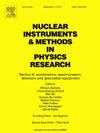Performance and longevity of CO2 based mixtures in CMS improved Resistive Plate Chambers in the HL-LHC environment
IF 1.5
3区 物理与天体物理
Q3 INSTRUMENTS & INSTRUMENTATION
Nuclear Instruments & Methods in Physics Research Section A-accelerators Spectrometers Detectors and Associated Equipment
Pub Date : 2025-04-03
DOI:10.1016/j.nima.2025.170451
引用次数: 0
Abstract
Resistive Plate Chamber (RPC) detectors are widely used in high-energy physics experiments. In the Compact Muon Solenoid (CMS), the RPC gas mixture is composed of 95.2% CHF, which generates a large number of ion-electron pairs, 4.5% iCH10 to suppress photon feedback effects, and 0.3% SF as an electron quencher to ensure operation in streamer-free mode. Given the high global warming potential (GWP) of CHF at 1430 and the recent reduction in the emission of F gases imposed by the European Union, efforts have intensified in recent years to explore environmentally friendly gas alternatives. A promising short- to mid-term solution for the upcoming years of Large Hadron Collider (LHC) operations is to lower the GWP of the RPC gas mixture by partially substituting CHF with CO. The performance tests of the alternative gas mixtures are conducted at the CERN Gamma Irradiation Facility (GIF++) in the North Area of the Super Proton Synchrotron (SPS), where a 13.6 TBq radiation source and an SPS muon beam simulate the High-Luminosity (HL) Phase II conditions of the LHC. This paper reports on the performance of a 1.4 mm gap RPC using three different CO-based mixtures under intense gamma radiation, with the first results on the longevity campaign.
CMS中CO2基混合物的性能和寿命改善了HL-LHC环境中的电阻板腔
电阻板室探测器在高能物理实验中有着广泛的应用。在Compact Muon螺线管(CMS)中,RPC气体混合物由95.2%的C2H2F4组成,C2H2F4产生大量的离子-电子对,4.5%的iC4H10抑制光子反馈效应,0.3%的SF6作为电子猝灭剂确保在无流光模式下运行。鉴于C2H2F4的全球变暖潜能值(GWP)高达1430,以及最近欧盟要求减少F气体的排放,近年来人们加大了探索环保气体替代品的力度。对于即将到来的大型强子对撞机(LHC)运行来说,一个有希望的中短期解决方案是通过用二氧化碳部分取代C2H2F4来降低RPC气体混合物的GWP。在欧洲核子研究中心(CERN)位于超级质子同步加速器(SPS)北区的伽马辐照设施(GIF++)上进行了替代气体混合物的性能测试,其中13.6 TBq辐射源和SPS μ介子束模拟了LHC的高亮度(HL)第二阶段条件。本文报告了在强伽马辐射下使用三种不同的二氧化碳基混合物的1.4 mm间隙RPC的性能,并获得了长寿运动的第一个结果。
本文章由计算机程序翻译,如有差异,请以英文原文为准。
求助全文
约1分钟内获得全文
求助全文
来源期刊
CiteScore
3.20
自引率
21.40%
发文量
787
审稿时长
1 months
期刊介绍:
Section A of Nuclear Instruments and Methods in Physics Research publishes papers on design, manufacturing and performance of scientific instruments with an emphasis on large scale facilities. This includes the development of particle accelerators, ion sources, beam transport systems and target arrangements as well as the use of secondary phenomena such as synchrotron radiation and free electron lasers. It also includes all types of instrumentation for the detection and spectrometry of radiations from high energy processes and nuclear decays, as well as instrumentation for experiments at nuclear reactors. Specialized electronics for nuclear and other types of spectrometry as well as computerization of measurements and control systems in this area also find their place in the A section.
Theoretical as well as experimental papers are accepted.

 求助内容:
求助内容: 应助结果提醒方式:
应助结果提醒方式:


